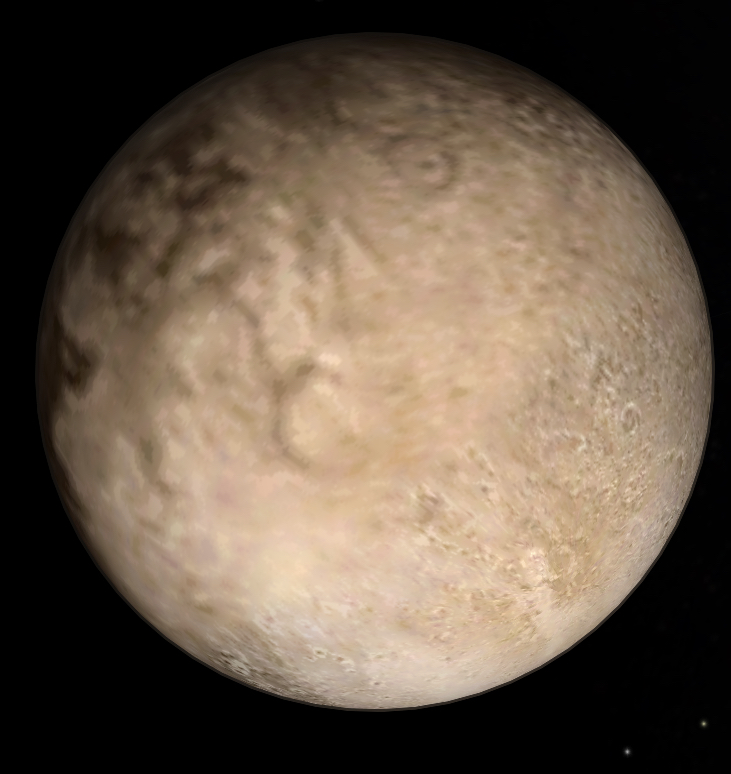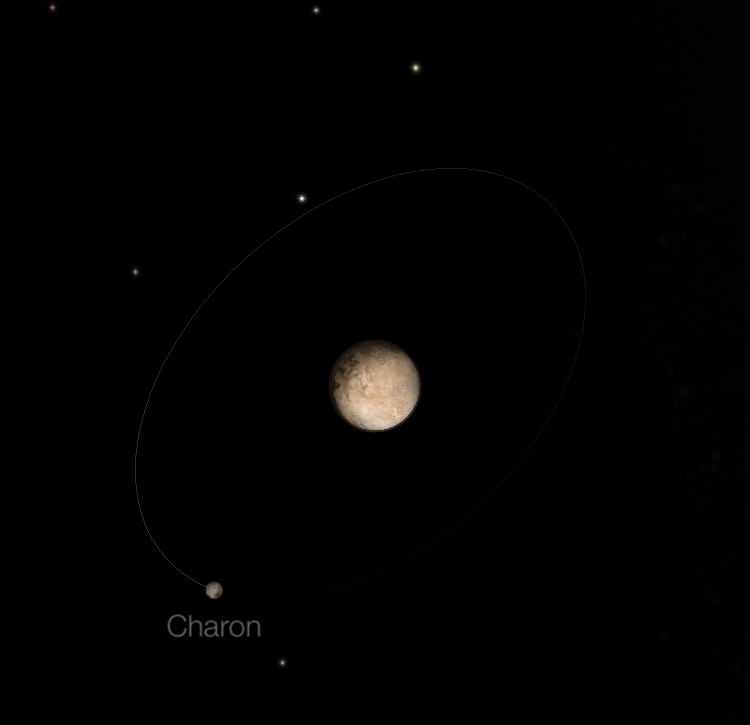2020. 8. 12. 21:36ㆍSky observation

Until 2006, Pluto was counted as the ninth planet in the solar system. It is much smaller than any of the other planets, and has a highly elliptical and inclined orbit unlike the others. Today, Pluto is no longer considered to be a planet, but is rather the first of a new category of objects called dwarf planets.
Pluto's moon Charon is the largest in the Solar System, relative to the body it orbits. In 2015, Pluto and Charon were visited by the New Horizons spacecraft, and became the farthest planetary system in the Solar System yet to be explored.
History and Mythology
Pluto was discovered in 1930 by the American astronomer Clyde Tombaugh, working at Lowell Observatory. This observatory, founded by Percival Lowell of Mars fame, was dedicated to the task of finding a "Planet X" after observations of Uranus and Neptune in the late 19th century caused astronomers to speculate that Uranus's orbit was being disturbed by another planet in addition to Neptune. Tombaugh found Pluto near Planet X's predicted position after a year of searching.

The photographic plates, taken on January 23rd and January 29th, 1930, on which Clyde Tombaugh discovered Pluto.The arrows point to Pluto's position on each plate. (Lowell Observatory Archives)
The discovery of Pluto made headlines across the globe. The name Pluto was proposed by an 11-year-old English schoolgirl named Venetia Burney. Pluto, the Roman name for the god of the underworld, seemed appropriate for such a dark and distant planet. The first two letters of Pluto are also the initials of Percival Lowell, and Pluto's astronomical symbol is a monogram constructed from the letters PL.

Ancient Roman mythology has Pluto as the Lord of Death, burials, and mourning for the dead; he is identified with the Greek god Hades. Ironically, one of Pluto's epithets is also Lord of Riches, for his connection to minerals and gems found deep inside the Earth - a plutocracy is a society ruled by the wealthy. Pluto was often pictured bestowing the blessings of new life from a cornucopia.
Declassification and Dwarf Planets
In 1978, astronomer James Christy discovered that Pluto has a moon of its own, named Charon after the ferryman of the dead. Observations of Charon allowed the mass of Pluto to be computed directly for the first time, and it was found to be less than 0.2% the mass of the Earth. Pluto's small size and mass cast doubt on the idea that Pluto could be Planet X. With a revised estimate of the mass of Neptune after the 1989 Voyager 2 flyby, the discrepancies in the position of Uranus - and with them, the need for Planet X - vanished. Today the consensus among astronomers is that Planet X does not exist, and that Tombaugh found Pluto by coincidence.
As astronomers began to discover other objects in the outer solar system beyond Neptune - some larger than Pluto - it became clear that Pluto did not deserve major planet status. In 2006, the International Astronomical Union officially de-classified Pluto as a planet, and gave it the minor planet designation, (134340) Pluto. The 2006 IAU resolution specified three conditions for an object to be considered a planet:
1. It must be in orbit around the Sun, not another planet (or moon).
2. It must be massive enough to have pulled itself into the shape of a sphere by its own gravitational force.
3. It must be gravitationally dominant enough to have "cleared the neighborhood" around its orbit of other bodies of comparable size.
A large body which meets the first two criteria for a planet, but has not cleared its neighborhood is classified as a "dwarf planet". Along with Pluto, the IAU currently recognizes four other dwarf planets in our Solar System: Ceres, Eris, Haumea, and Makemake.
Orbit
Pluto orbits the Sun once every 248 years. Pluto's orbit is quite eccentric, and takes Pluto from about 30 A.U. to about 48 A.U. from the Sun. For a few years during every orbit, Pluto is actually closer to the Sun than Neptune. Pluto's orbit also highly inclined to the Ecliptic (by about 17 degrees). This high inclination helps Pluto avoid a collision with Neptune, since when their orbits cross, Pluto is far above the plane of the solar system.
Pluto's orbit within the Kuiper Belt (NASA).
Pluto orbits in a zone known as the Kuiper Belt. This region lies beyond the orbit of Neptune, and is believed to contain hundreds, if not thousands, of bodies similar to Pluto. Pluto is also the prototype and namesake of a group of objects called Plutinos. The Plutinos orbit in the same region of space and, like Pluto, have a 2:3 orbital resonance with Neptune (completing 2 orbits for every 3 orbits of Neptune). In addition to Pluto, the other largest Plutinos include (90482) Orcus, (28978) Ixion, (38083) Rhadamanthus, and (38628) Huya.
Size and Composition
New Horizons measured Pluto's diameter at 1473 miles (2370 km), confirming that Pluto is larger than all other known objects beyond Neptune. Yet Pluto is still only two-thirds the size of the Earth's Moon. Pluto's density is also low (about 2 grams per cubic centimeter) so it contains only about one-sixth the mass of the Moon. If you weighed 100 pounds on Earth, you would only weigh 8 pounds on Pluto. Pluto's rotational axis is also tilted about 120 degrees to the Ecliptic, so it has a retrograde rotation, like Uranus and Venus.
Because Pluto and Charon are so small and far away, they are extremely difficult to observe from Earth. Between 1985 and 1990, Pluto and its companion, Charon, were situated in such a way that many mutual eclipses and transits occurred. Observing these events led to a wealth of data, including a surface albedo map showing that Pluto has polar caps, dark spots, and light areas.
New Horizons revealed much more detail during its July 2015 flyby. Pluto is one of the most contrastive bodies in the Solar System. Its surface is quite varied in brightness and color, from charcoal black to dark orange and white. A very bright heart-shaped region near Pluto's equator was named Tombaugh Regio, after Pluto's discoverer. The western half of this region is a craterless, flat plan named Sputnik Planum. The smooth expanse of this icy plain is flanked by rugged mountains, the Norgay Montes and Hillary Montes, up to 3.5 km (2 mi) high.
The first close-up images from New Horizons showed miles-high mountains and smooth plains, but very few impact craters. This surprising discovery means that Pluto's surface is less than 100 million years old - very young in geological terms. Activity may still be happening today, but the power source behind such activity is unexplained.
Pluto's surface is covered with more than 98% frozen nitrogen, with traces of methane and carbon monoxide ice. The face of Pluto oriented toward Charon contains more methane ice, whereas the opposite face contains more frozen nitrogen and carbon monoxide. Sputnik Planum appears to be composed of ices more volatile than the water-ice bedrock of Pluto, including carbon-monoxide ice. Snow or ice from the plain appears to have been blown in a thin layer, forming the large, bright Tombaugh Regio.
Glaciers of nitrogen ice can be seen flowing from Sputnik Planum into adjacent depressed valleys, which appear to have formed through erosion. Mountains several kilometers high along the edges of Sputnik Planum are probably made of water ice - the only ice detected on Pluto strong enough at Plutonian temperatures to support such heights. Two possible cryovolcanoes, provisionally named Wright Mons and Piccard Mons, have been identified.
New Horizons of mountains and glaciers near the edge of Pluto's 'Heart'. (NASA)
Scientists think that Pluto's internal structure is differentiated, with a dense rocky rocky core approximately 70% of Pluto's diameter surrounded by a mantle of water ice. Decay of radioactive elements would heat the ices enough for the rock to separate from them. Such heating may possibly continue today, creating a subsurface ocean of liquid water at the core-mantle boundary.
Pluto has a very thin atmosphere of nitrogen, methane, and carbon monoxide which freezes and falls to the surface when Pluto is farther from the Sun. Pluto's average surface temperature is -370°F (-220°C). The surface pressure ranges from roughly 100,000th to 1 millionth of Earth's atmospheric pressure.
The presence of methane in Pluto's atmosphere - a powerful greenhouse gas - creates a temperature inversion. As New Horizons passed Pluto, it captured a backlit view of haze in the dwarf planet's atmosphere.
The Moons of Pluto
Pluto has five known moons. Charon, by far the largest, was discovered in 1978. Charon is about half the size of Pluto and about 1/8th as massive: ten times more massive than the Earth's moon relative to Earth. Both objects are tidally locked, always showing the same face to each other. Charon and Pluto orbit each other closely, every 6.39 days, around a common center of mass which lies outside the surface of either body. For this reason, Pluto and Charon are often referred to as a "double planet".
Scientists photographing Pluto with the Hubble Space Telescope in preparation for the New Horizons mission found four smaller bodies: Nix and Hydra (discovered in 2005), Kerberos (2011), and Styx (2012). All four are much smaller than Charon, and orbit far outside the Pluto-Charon pair.
The 2012 discovery of Pluto's fifth moon "P5" (Styx) by the Hubble Space Telescope caused concerns that even smaller objects might exist around Pluto, possibly presenting a hazard to the spacecraft. But no additional moons were found by New Horizons during its July 2015 flyby.

New Horizons revealed spectacular canyons and mountains on Pluto's largest moon, Charon. It also provided lower resolution of the irregularly-shaped smaller moons Nix and Hydra.
From skyportal
'Sky observation' 카테고리의 다른 글
| 유로파 (0) | 2020.08.20 |
|---|---|
| Andromeda Galaxy (0) | 2020.08.13 |
| Neptune (0) | 2020.08.11 |
| 천왕성 Uranus (0) | 2020.08.08 |
| 광학 망원경 유형 -Optical Telescope Types (0) | 2020.08.05 |